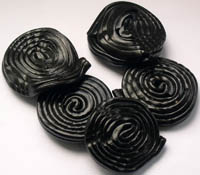
Willing to try a licorice-based toothpaste?
When it comes to candy, certain flavors fall into a category that tends to require a more sophisticated palate. That's my decidedly non-scientific assessment having watched my own kids and their love-hate (mostly hate) relationship with all things "mint," something to which dental-care product developers really should pay more attention since many "kid" pastes still have a bit of mint "bite" to them. After witnessing thousands of mint-related shrieks and mini-rebellions, I've thought about the way our palates change and grow with time. We know this about spinach and brussels sprouts, right? But clearly there are certain flavorings, as well, that we potentially grow into (and out of).
Already there has been a softening to mint. For a while, we dumped strawberry toothpaste and existed harmoniously with a single tube of mint, but it was short-lived. Someday, I have no doubt they may prefer a real candy cane in December to a sickly, sweet and sour, fruit punch flavored one. Someday, I am sure they'll look at me in disbelief when I recount the fit thrown at the dentist when one selected a chocolate toothpaste from the picture-based menu only to realize when it hit the tongue that it was chocolate mint. For now, even mint-flavored dental floss is frowned upon, and in reality, most dental flosses have at least a hint of mint.
Mint isn't the only category of candy flavoring that seemingly grows on one with age. While, personally, I look back fondly on the world of Atomic Fireballs, Hot Tamales, and even Big Red chewing gum, which my grandfather stocked in his shirt pocket, along with Juicy Fruit (I guess I pre-date the sugarless gum industry!), my kids won't come near cinnamon-flavored candies. I doubt they'd cozy up to something ginger-flavored or black-licorice flavored either.
I remember liking black licorice, and as an adult, I can vouch for the goodness of a chocolate-ginger combo, but I can't imagine my kids opting for either over something sweet, sour, and sure-to-turn-the-tongue-bright-blue.
It's too bad, because a toothpaste with a base of licorice root might help safeguard our trips to the dentist's office!
The "Root" of Things
Recent studies have shown that licorice root has benefits for oral health—cavity-fighting benefits. Scientists behind a study in the American Chemical Society's (ACS) Journal of Natural Products cite licorice root as being instrumental in helping fight both tooth decay and gum disease. Licorice root has been used in Chinese traditional medicine for various reasons, and to enhance the properties of other herbal additives, but the recent US-based study focused specifically on the effect of compounds in licorice root on bacteria common to the mouth. According to studies, licoricidin and licorisoflavan A, two compounds found in licorice root, help inhibit the growth of bacteria that cause cavities as well as bacteria related to gum disease.
In reality, however, those looking to take advantage of licorice-laden oral healthcare will need to find their licorice somewhere other than the candy aisle because licorice root is commonly replaced by anise oil in candies. So if you decide to add licorice to your list, be sure and check package labels and ingredients.
Making Connections
Tooth decay is a widespread problem, but it is one that can be helped with both preventive and routine care. According to the CDC, "tooth decay affects more than one-fourth of U.S. children aged 2-5 years and half of those aged 12-15 years." Those are high percentages, as is this startling statistic: "one-fourth of U.S. adults aged 65 or older have lost all of their teeth."
Can licorice root make a difference? How safe is licorice root? How much can be taken? For how long? Are there other risks?
These are just a few of the questions researchers have to consider and explore, and there are already warnings accompanying stories about the benefits of licorice root that indicate there are counter-risks related to blood pressure and potassium levels. Licorice root is also a legume, which raises additional considerations for those concerned about gluten. As one might expect, licorice-root Altoids® probably won't suddenly be appearing in the dental health aisle as an end-all solution to oral health.
Further exploration, however, seems prudent, and students can jump in by learning more about the ways in which licorice root interacts with oral bacteria.
Taking it Further
Students interested in designing an independent science project focused on the anti-bacterial properties of a substance like licorice root may find the underpinnings of their project in the The End Zone: Measuring Antimicrobial Effectiveness with Zones of Inhibition Project Idea, adapted to use licorice extract and bacteria cultured from swabbing the inside of the mouth.
As with any bacteria-based project or study, however, it is important for students to fully review and be mindful of SRC guidelines and rules regulating bacteria projects. The Science Buddies Microorganisms Safety Guide offers additional information.
0 comments:
Post a Comment